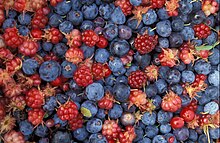Alaskan ice cream
A request that this article title be changed to Alaskan ice cream is under discussion. Please do not move this article until the discussion is closed. |
 Alaska wild berries from the Innoko National Wildlife Refuge, a mixture of true berries (blue Vaccinium uliginosum and red Vaccinium vitis-idaea) and aggregate fruits (red Rubus arcticus). These berries are used in Indian ice cream. | |
| Alternative names | Native ice cream, Alaskan ice cream |
|---|---|
| Type | Dessert |
| Place of origin | United States |
| Region or state | Alaska |
| Created by | Alaskan Athabaskans |
| Main ingredients | dried fish or meat, fat, berries |
Alaskan Indian ice cream is a dessert made of dried fish (especially pike, sheefish or inconnu, whitefish or cisco, freshwater whitefishes), dried moose or caribou meat and fat and berries (especially cowberry, bilberry, cranberry, bearberry, crowberry, [high-bush] salmonberry, low-bush salmonberry, raspberry, prickly rose) or mild sweeteners such as roots of Indian potato or wild carrot, mixed and whipped with a whisk or formerly hand made by Alaskan Athabaskans. The most common recipes for Indian ice cream consist of dried and pulverized moose or caribou tenderloin that is blended with moose fat (traditionally in a birch bark container) until the mixture is light and fluffy. It may be eaten unfrozen or frozen, and in the latter case it somewhat resembles commercial ice cream.[1]
Both akutaq (Eskimo ice cream) and Indian ice cream are also known as native ice cream or Alaskan ice cream in Alaska. Not to be confused with Canadian Indian ice cream (or sxusem) of First Nations in British Columbia and kulfi (or Indian ice cream) from the Indian Subcontinent of Asia.
The "ice cream songs" used to be sung during the preparation of Alaskan Athabascan Indian ice cream.[2]
Native names
| Athabaskan language | ice cream | literally |
| Ahtna | ? | |
| Dena’ina | nivagi[3] | |
| Deg Xinag | vanhgiq[4][5] | |
| Holikachuk | nathdlod[5] | |
| Koyukon | nonaałdlode[6] | "creamed one" or "that which has been whipped up" |
| Upper Kuskokwim | nemaje[7][8] | |
| Lower Tanana | nonathdlodi[2] | |
| Tanacross | nanehdlaad[9] | |
| Upper Tanana | ? | |
| Gwich’in | it’suh[10] | |
| Hän | ? |
See also
References
- ^ Priscilla Russell Kari, Tanaina Plantlore, Dena'ina K'et'una (1987), p. 61.
- ^ a b "Keynote abstracts - HLK 2010, Lund University". Conference.sol.lu.se. Retrieved 23 April 2018.
- ^ "Land Use and Economy of Lime Village" (PDF). Subsistence.adfg.state.ak.us. Retrieved 23 April 2018.
- ^ "Course: Deg Xinag Learners' Dictionary". Ankn.uaf.edu. Retrieved 23 April 2018.
- ^ a b "ABCD" (PDF). Adfg.alaska.gov. Retrieved 23 April 2018.
- ^ "EFGH" (PDF). Subsistence.adfg.state.ak.us. Retrieved 23 April 2018.
- ^ The Upper Kuskokwim People and Gathering Plants in the Upper Kuskokwim Archived December 24, 2012, at the Wayback Machine
- ^ "Whitefish Biology, Distribution, and Fisheries in the Yukon and Kuskokwim River Drainages in Alaska: a Synthesis of Available Information" (PDF). Rapidresearch.com. Retrieved 23 April 2018.
- ^ Tanacross Learnersʼ Dictionary by I. S. Arnold, G. Holton, and R. Thoman (2009)
- ^ "Gwich'in Social & Cultural Institute". Plants.gwichin.ca. Retrieved 23 April 2018.
